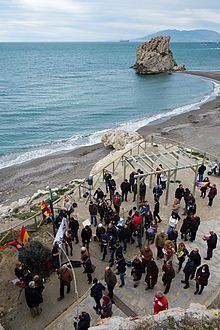Start date February 8, 1937 | ||
 | ||
The Málaga–Almería road massacre was a detrimental attack on the republican-dominated city of Málaga, Spain and its citizens on 8 February 1937 during the Spanish Civil War. The city was penetrated by pro-Franco and Spanish Nationalist troops as well as fascist and nationalist-minded Italian and German reinforcements. An estimated 5,000–15,000 civilians attempted to evacuate the besieged city via the N-340 coastal highway connecting Málaga to the city of Almería.
Contents
Background
On April 12, 1931, Spain celebrated its first democratic elections since the dictatorship of Miguel Primo de Rivera. The elections resulted in the formation of the Spanish Second Republic. Consequently, a great divide was created among two of the more prevalent political ideologies of the time. Francisco Franco (1892–1975) led nationalist efforts out of northern cities such as Zaragoza, Pamplona, Burgos, and La Coruña, northern/central rural areas, and the southern city of Sevilla. The republican zone accounted for southern/central regions and cities, such as Murcia, Valencia, and Madrid, as well Barcelona and Cataluña (Catalonia) to the east and Bilbao and Oviedo along the northern coast. The goal of the Nationalists was to reinstate a politically, socially, and religiously conservative society unified by Catholicism and a self-sufficient economy. On the other hand, the Republican movement was characterized by more reformative and socialist principles. This movement was led by Manuel Azaña until 1931, followed by the Spanish Confederation of Autonomous Right-wing Groups (Confederación Española de Derechas Autónomas [CEDA]) from 1933–1936. Consequently, Spain was confronted with three main complications: capitalism versus communism; fascism versus communism; authoritarian systems versus democratic systems.
El golpe de estado was a coup d’etat led by Franco on July 18, 1936. As a result of this governmental disturbance, the Spanish Civil War began that same year.
Aside from the capital city of Sevilla, the southern autonomous community of Andalucía (Andalusia) was primarily partial to the republican efforts during the war. Málaga, a "republican" city on the southern coast of Andalucia, was soon targeted by pro-Franco forces. On January 17, 1937, nationalist forces led by General Queipo de Llano (1875–1951) were sent to seize Granada, Marbella, Ronda, and other surrounding areas. These actions were not perceived by republican authorities to require immediate retaliation or preparation. However, the diligent nationalist force greatly outnumbered the army in Málaga. Franco’s regime consisted of his own Spanish supporters, approximately 10,000 Italian “Blackshirts," German supporters, and even troops from the cities of Ceuta, Melilla, the Canary Islands, and the Balearic Islands. Meanwhile, only 12,000 republican troops were prepared to defend Málaga with 8,000 guns.
Attack on Málaga
On February 3, 1937, the pro-Franco forces were met by republican opposition in Ronda as they neared the city of Málaga. However, the defensive efforts were squashed. The city of Málaga was soon besieged by Franco's army. Italian troops attacked the city from the surrounding highlands on February 6, forcing the evacuation of civilians from the city. February 8, 1937 marked the fall of Málaga to pro-Franco forces. The city was attacked by land, air, and sea. Troops infiltrated Málaga with guns and tanks, while Italian and German aerial and marine forces bombed and burned the city.
Due to its geographical location along the southern coast of the Mediterranean Sea and its mountainous, inland boundaries (i.e. Sierra Morena and the Baetic System) the city of Málaga was limited in means of transport and evacuation. As a result, thousands of citizens in Málaga were left defenceless and unprepared for the attacks at the hands of the nationalist forces. Therefore, on February 8, a roughly estimated 15,000–50,000 civilians, chiefly the elderly, women, and children, fled to the city of Almería nearly 125 mi (200+ km) to the northeast via the main coastal highway, the N-340 road (la carretera N-340). The frantic civilians travelled unprotected along the highway were slaughtered. The Spanish national airforce, which was protecting the Second Republic, was unable to halt the attacks.
Consequences
Approximately 3,000–5,000 citizens of Málaga were killed en route to Almería. Mothers carrying children were slaughtered, leaving many defenseless and injured children along the way. The elderly, the injured, and those physically, emotionally, and spiritually incapable of completing the trek were swiftly eradicated. Various accounts from the 1960s claim that corpses could still be found alongside the highway from the aerial and ground attacks.
Those who reached Almería were largely rejected by the city’s citizens out of fear of the daunting and encroaching Franco regime. Those who declined to evacuate Málaga (approximately 4,000 people) were systematically rounded-up, raped, killed, and piled into mass graves, such as the San Rafael Cemetery.
Memoriam
The Málaga–Almería road massacre serves as a dark reminder of the political, economic, social, and religious unrest that plagued Spain during the 20th Century. This massacre also serves as a historical precursor for the ensuing adversities in Europe associated with fascism and neo-nationalism, such as the Holocaust.
In 2005, a memorial service was initiated in Torre del Mar (approximately halfway between Málaga and Almería) to honor the victims of the massacre. Since then, it has become a tradition to create a memorial wreath for the victims every February 7.
